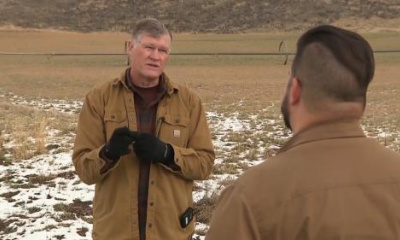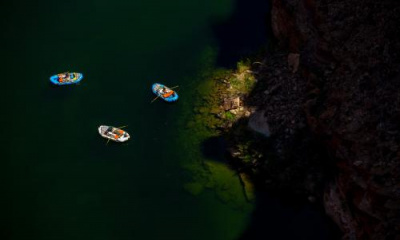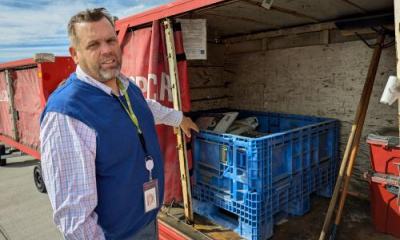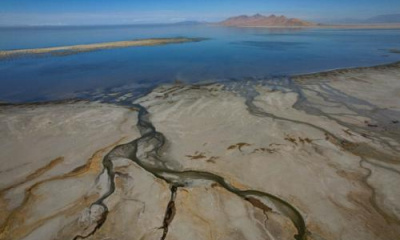The Great Salt Lake Watershed Enhancement Trust — created to improve water quantity and quality for the lake — released its five-year strategy this week.
The Utah Legislature created the Trust with $40 million in 2022 to help get water back to the struggling lake, which fell to a record low in 2022. The Trust’s mission also includes protecting and restoring wetlands in the lake’s ecosystem. According to its impact statement, the Trust has spent or committed nearly $16 million so far, including $813,000 on water transactions and $8.5 million on wetlands protection and restoration. Regarding water rights, it has secured:
- 21,000 acre-feet of permanent water for the lake,
- 33,000 acre-feet of water per year over multiple years and
- 2,800 acre-feet in one-time donations. Another 7,200 acre feet of one-time donations were approved but couldn't be delivered in 2023. The Trust is hoping to get that water to the lake in 2024.
For context, the Great Salt Lake Commissioner’s office estimates the lake needs 471,000 to 1 million acre feet a year each year for 30 years, depending on drought conditions, to restore the lake to 4,198 feet. It currently sits at 4,194.3 feet.
Marcelle Shoop, director of the Saline Lakes Program for the National Audubon Society, which co-manages the Trust with The Nature Conservancy, spoke and emailed with me this week about how much money the trust needs and how much more water it hopes to secure.
The conversation has been edited for length and clarity.
How much water do you want dedicated to the lake by 2028?
By 2028, we have several goals, one of which is undertaking water transactions, both to protect existing flows and [secure] new water flows up to at least 100,000 acre feet.
How close are you to that and how did you come up with that number?
The Trust was launched last year in January of 2023. We've been working with the Utah Division of Forestry, Fire and State Lands and Division of Wildlife Resources and others on a number of transactions. We're starting out 2024 with a baseline of 54,000 acre feet of water. So the gap that we're trying to close is 46,000 acre feet.
Many of the water transactions to date have been large water donations, either permanent or on a multi-year basis. Going forward we may not have as many large transactions or donations of that scale. That means undertaking more, but likely smaller paid transactions to reach the goal. The Trust has made assessments of water that might be available in the basins around the lake for lease, for example. This helped to inform the goal for the next five years, but the goal is still a stretch.
The 54,000 acre feet of water the Trust secured for the lake includes the permanent donation from the Church of Jesus Christ of Latter-day Saints?
Right. We have three large water donations from three entities that are on a multi-year lease. This includes Rio Tinto Kennecott, Central Utah Water Conservancy District and the Jordan Valley Water Conservancy District. And those are all in the Jordan River Basin.
There have been a lot of water reuse claims that could take away treated wastewater, the only water guaranteed to reach the Great Salt Lake. What's the Trust's role in protecting that water source?
We’d like to find opportunities to work with the owners of the treated wastewater flows to find ways to keep that water in the natural system.
More funding is one of your goals as well. The report says you need $110 million to $145 million for the next five years. That suggests it will be expensive to acquire the remaining 46,000 acre feet.
The additional funding addresses all of the goals, including water transactions and wetlands protection or restoration. Our team examined different scenarios and portfolios to come up with a range. Both water rights/shares and wetlands restoration can range in cost depending on market values, or the underlying transaction or project. Most of the water transactions to date have been donations. Going forward, it will require more investment, even with some additional donations.
The Trust team will continue to implement the work we need to to try to identify good opportunities where the person or the party with the water right or the water share is interested in leasing, we could figure out a way to get it to the lake and compensate for that.
Who do you buy or lease from? Have you identified the people or organizations to approach?
One of the things our strategy talks about is our need and desire to engage the agricultural community more. We've had discussions with some agricultural producers and irrigation companies. And we look forward to investigating more opportunities with the agricultural community.
Land has been urbanized very rapidly in the valley, and we have received inquiries from people who may no longer need the water rights or shares. We also have had good opportunities to coordinate with water districts and other government entities who have water they may be able to contribute on a temporary basis.
The state of Utah is typically a partner on the transactions. Either or both the Utah Division of Wildlife Resources, or the Division of Forestry Fire and State Lands, will act as the holder of the lease or the water right to put it to beneficial use at the lake.
The strategy says that you can help foster support of viable agricultural enterprises, and that you'd work with agricultural partners to leverage investments in agricultural water optimization. Can you talk more about what that looks like?
There are some producers that really would like to implement projects that would reduce their water consumption, where they may have extra water that they could essentially contribute to the environment, maybe through a lease or through saved water, for example, under some of the new legislation, for example. Additionally, there's the concept of split season leasing, where somebody maybe doesn't do the last cutting of hay or doesn't do their fall crop. And so there are opportunities to work with them. And you know, by doing that, it does help keep those farmers viable and in their business, but also has multiple benefits for the lake and the environment. So we want to continue having those dialogues and looking for opportunities. And some of that may be just piloting and seeing how it works. There are new policies that have come into play, and that will help with this.
Pivoting to wetlands, you have a goal of protecting and restoring at least 20,000 acres of wetlands around the lake. How close are you to that goal?
Last year the Trust awarded eight wetlands projects $8.5 million, with applicants providing match funding of $6.5 million. The applicants have identified a little more than 13,000 acres of wetlands that will benefit from the projects. The Trust wants to build on that. Of the initial $40 million in state funding, $10 million is dedicated to wetlands restoration or protection that can benefit hydrology of Great Salt Lake. And so we're looking to the future in terms of what might be achievable in that five-year window. And so, that is how we focused in on another 7,000 acres of wetlands.
A lot of wetlands are at risk of being developed through inland port proposals. What is the Trust's role, if any, in protecting those wetlands through this project?
To date the Trust has awarded funding to other entities to support the work that they're doing on Great Salt Lake wetlands restoration. And that said, we're looking at some studies that could help identify important areas to protect, including the water flows needed to make sure that water flows going to wetlands are protected long term, because you need those water flows in order to have the wetlands and we do have a lot of small flows around the lake that are really important to protect, to keep that that ecosystem health.
With respect to inland port proposals, the Trust is not a policy organization and does not advocate. However, there are still opportunities to communicate with the relevant local jurisdictions concerning the nature and importance of the wetlands habitats and the relationship to lake hydrology and opportunities to protect or restore wetlands habitats.
Is there anything else you want to add?
One of the things that we've recognized is it is important and exciting to test out how the water transactions and figuring out water distribution can work to help flows to the Lake. The Trust’s undertaking is complex and challenging, so it has been amazing to see how many organizations, agencies and individuals are interested in trying to find ways to contribute or help solve the water challenges for the lake and its wetlands. The Trust team knows we have more opportunities to reach out and work with communities, agriculture and tribes and we're looking forward to doing that and continuing to test new ideas.
The Nature Conservancy helps support the Great Salt Lake Collaborative. Editorial decisions are made independently and are not influenced by donations.







